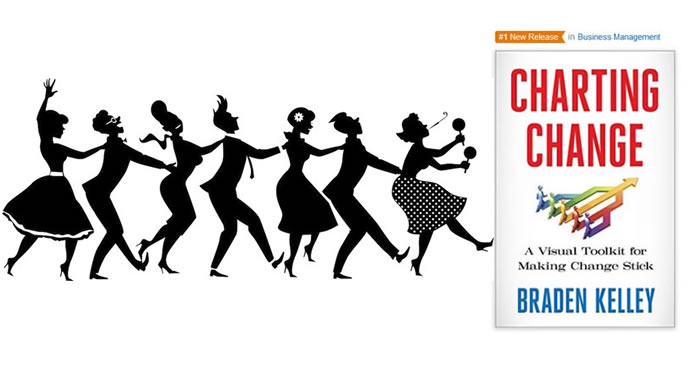
GUEST POST from Stefan Lindegaard
Here you get 39 hacks that can help yourself and your organization in its digital transformation efforts. The hacks are divided into these six main categories:
- Corporate Mindset
- Personal Leadership / Executives
- People – Mindset, Skills and Toolbox
- Organizational Structures and Processes
- Networking and Ecosystems
- Tools
This is work in progress and Grimur Fjeldsted, my co-author and partner at Transform XO and myself are very open to your feedback and input. Get in touch!
Here we go with the hacks.
1. Corporate Mindset
Strategy for a digital world: Your company needs new approaches to strategy that must be rooted in the belief that there is no such thing as a digital strategy; just strategy in a digital world. Besides crucial digital focus, your strategy approach must also be built on speed and flexibility which means that you must listen, adapt, experiment and execute better and faster than ever before – and than what your competition does.
Profitability: Digital acceleration should be geared towards driving economic benefits aimed of keeping – or developing – a healthy culture of profitability. So focus on growth and profitability and know that when setting up something new, it does not always mean that the old is bad. The key is to know the gaps and build the bridges.
Create a vision statement: You need a vision statement in order to build the narrative for the digital transformation your organization must undertake. Build upon the visions you already have in place, but have in mind that you need to think as if you are already in a digital world.
Align digital efforts to vision and overall corporate strategy: Executives – and later on their teams and the rest of the organization – need to think of digitalization as a tool to reach the goals stated in the corporate strategy – short, mid and long-term.
Ride the waves of merging industries: Exponential growth, mergers of technologies and disruption created by new business models will change the supply and value chains that make up the industries as we know them today. This will happen faster in some industries than others, but every company need to prepare themselves to be disrupted. Digital is a key enabler.
Be competitively unpredictable: Either your industry stays the same or it will be disrupted significantly in the coming years. The challenge is that you don’t know which scenario wins, so you need to prepare the organization to face either option. Agility is key for this. If you decide to be proactive on this and if you read the merging of industries right, you are on the way to become competitively unpredictable.
Develop the digital compass: Knowing where to go in the digital world is one of the biggest challenges. In this context, you must look at digital for operational elements as well as digital for transformation/innovation efforts. This covers all aspects of digital from social media, e-commerce, digital life to big data, artificial intelligence and IoT. It is difficult developing a digital compass so be ready to experiment to find the right way forward for your organization.
Step up the communication efforts: You have to develop a common understanding and a common language around digital transformation. Build your communication strategy on the above efforts.
2. Personal Leadership / Executives
Go from doing digital to being digital: Internal and external forces with a special focus on the shifts in customer expectations require new approaches for dealing with digital. Did you company react to these changes by doing digital or by being digital? Getting to know your patterns of action will help you on the long journey of understanding what digital transformation really is about.
Know the leadership challenges: Who leads on digital in your organization? Is digital leadership spread across silos, functions and business units or is it unified? Who has the ownership of the touch-points in the customer, supplier, innovation and other journeys? Do you have the capabilities and infrastructure to be data-driven or do you rely on your gut instincts? If the leadership team does not get this, all other efforts will be in vain.
Build a core team and give executives skin in the game: Set up a small core team with a mix of top level executives (at best led by the CEO him or herself) and people with the right mindset and skills towards digitalization. This team must make things happen and the key elements are to set the direction, build the belief and remove the obstacles for digital transformation. Don’t turn this into a talk, talk committee. It has to be action-driven and people – including the executives – need to be hold accountable for its success.
Focus on the root causes, not the barriers: Too many executives and their chosen teams keep fighting the barriers, but they will not go away if you don’t attack the root causes. Root causes are different for each organization. Know yours.
Bring Emotional Intelligence (EQ) into digital efforts: Develop your ability to have successful conversations with others, up, down, sideways, inside and outside the organization. The ability to empathize impacts employee engagement, retention and performance and it is critical to good teamwork. It it also critical for customer engagement and ecosystem driven innovation. This is about interacting rather than managing. It is important today and even more so in a growing digital world.
Identify the heroes and make space for the first rebels: Who sounds the alarm horn, when the rest of the organization steers towards the abyss? You need to identify the heroes who really make a difference for your digital transformation and you must beware that many of the future heroes might have the label of being a rebel today. Once you know what to look for in people and later on who the heroes are, make sure they are close to your inner circle.
Build belief, instill a sense of urgency: First, the executives and their teams must believe – and upgrade their own mindset and competences. Then, they must build belief within the organization and external stakeholders. Communication including networking and stakeholder management is key. The paradox is that this must be done with a sense of urgency that very few people can understand.
Manage speed plus complexity: Today, we all try to handle speed, but in the near future it will also be about handling complexity. The rising complexity gives leaders headaches, and thereby resistance to take the first steps towards change. Establish a collective realization to embrace change og listen and adapt much more dramatically than ever before. Maybe AI will soon help us on this.
3. People – Mindset, Skills and Toolbox
Asses your digital maturity: You need to assess not only the organizational maturity but also your personal maturity for digitalization. Once you know your starting point as well as your objectives, it becomes easier to develop in the right direction. You can find many assessment tools online although it can take some time finding one that works for you. We are working on this.
Know your network and skills: Assess your network and skills with regards to the elements that are the most important for your work and career issues today and in the near future. If you read this, you already know that digital is important. The next questions to consider are how you can grow your network in this direction and context.
Learn in new ways: You need to challenge yourself constantly in the next couple of years in order to keep up with the best – or just stay relevant. You can do this through reverse mentoring, taking classes at platforms like Singularity and Udacity and by expanding your network in directions that works for your new future. As a starter, you could look into exponential growth and how this brings along merging technologies and even industries.
Embrace the positive aspects: There are so many public perspectives on digitalization and they are both positive and negative. If you want to prosper in this new era, you must embrace the positive aspects and explore the opportunities while still keeping a healthy balance by having a realistic view and understanding of the less positive consequences. And remember that the worst you can do is to do nothing at all.
4. Organizational Structures and Processes
New ways of working: Explore the “new” ways of working which often includes buzz words such as lean, agile, experimentation, MVP, holocracy, RACI and boss-less management. Adapt the ways that can work within your organization and experiment on how to bring the past and future together.
Don’t act like a startup: You are not one, but you should still adopt a beginner’s mindset. This means you need to look at things with a fresh perspective, stay curious and be open for experimentation while learning from the failures that come along with experimentation.
Experiment, implement and standardize on digitalization: Set up small teams that work in new ways, capture the lessons learned from successes as well as failures and communicate strategically about this. Build from this to float more projects into the organization and consider establishing a new competence center. Validate and standardize well consolidated working methods across the corporation and focus on the next development.
Break down silos, review governance structures: Internal resistance is often caused by business units and functions that are working towards different objectives. This will be a major issue with digitalization as it has strong impact across the board. Assess the processes, policies and systems that prevent success in this context. Update.
Educate in new ways: Forget Harvard, INSEAD, London Business School and all the other business schools that are rooted in the last century. Ok, that might be a tad too much, but you should definitely find ways to complement traditional training and educational efforts with the offerings by the likes of Singularity University and Udacity. Learn by doing and train the trainers.
Work with HR – when/if they are ready: Most HR teams lack a strategic role when it comes to corporate transformation, digitalization and innovation. This is a paradox as everyone agrees that people are the key element here. This has to change and the core team need to help them upgrade their capabilities in this context. If successful, HR becomes a powerful partner as they have a strong influence on corporate training including the executive level.
Don’t go full frontal with learning activities: Before you push learning, use 3-6 months to influence the executives by sharing short pieces of information and insights that fit their specific situation and objectives in the context of digital transformation. Build further on this to help them develop their own ideas on how digital can help their personal agendas. Then, develop a program to upgrade their mindset, skills and toolbox (and for their key people and teams). Make it action-driven.
Note: several of the below hacks on networks and ecosystems are also highly relevant to organizational structures and processes.
5. Networking and Ecosystems
Digital business models are platforms based on networks and communities: Products have features, platforms have communities and networks. Platforms are connected, collaborative and scalable. You do not have to replace your current business models based on products as the digital business models often live alongside the traditional ones (at least for now). The key is to learn the new rules of strategy based on a platform-driven world or begin planning your exit.
Develop a networked business structure: A next generation organization is highly networked. It is plugged into physical as well as virtual assets and resources and entrepreneurial and industrial ecosystems on a global scale. The external strategic stakeholders (current and potential) must be identified and mapped based on their role in the value chain, business model ecosystem and/or supply chain. Better interaction and flow across ecosystems must be enabled.
The internal networked business structure: The same as the above needs to be done internally where the focus is also to break down silos. Here it is critical to know how to navigate the fine line between the existing corporate culture and the different culture that is often needed for a successful transformation. A mindset upgrade program must be initiated in this context, and key internal resources should get their feet wet fast.
Form a strategic alliance with IT: You cannot do it without them. But make sure IT also sees opportunities that everyone can pursue together rather than just risk that IT wants to shut down.
Be the accelerator for your ecosystems: Strive to become the accelerator that brings together your ecosystems and takes the lead in developing the services, processes and products needed for everyone to win with digitalization.
Win early and reap the benefits: The key benefit of being perceived as the thought/action leader within your industry and the preferred partner of choice within your (innovation) ecosystems is that your organization get the first look on new opportunities as well as the important heads-up on new directions within the industry.
Work with multi-layered approaches: Today, networking and ecosystems is not just organizations with its teams and people working with other organizations and their teams and people to form ecosystems. It is also the digital and virtual infrastructures of these companies and ecosystems. Furthermore, we need to have in mind that competition today is not between two or more companies, but between two or more ecosystems.
6. Tools
Current versus new services, systems and tools: What is already in place to facilitate digital transformation? How do we learn what else is needed? How do we get the new things and how do we bridge the new and the existing in ways that build competitive advantages? Getting the overview here is a job for the top executives. You might need new tools just to get this overview.
Tap into existing structures and opportunities for digital development: Many companies and service providers have been working on digital transformation for years. Just think of Watson in general (and their narrow approaches towards health and law) and the new partnership between IBM and Salesforce with regards to digital-driven sales structures. As above, you first need the overview and then you find out how to tap into what is already on the market and link this with your own efforts.
Metrics and KPI’s in a digital world: Many traditional metrics are outcome-driven in the sense that they are based on 1-3 year old decisions and the actions taken around these decisions. In the future, we need to balance traditional metrics and KPI’s with new ones that focus more on behavior in order to provide an overview of the corporate capabilities and a sense of the direction that the organization and its partners is taking. This is important in order to facilitate much faster strategy development processes and even faster responses to the markets.
Harness the power of big data: This will be the starting point for many organizations. You can start start small by forming data collection and insight teams and build up your analytical capabilities. But starting small does not mean that you should not invest heavily in this. If you are at this stage, you are years behind and you have to catch up fast.
Use digital to work smarter, not harder: What good are all the tools if they do not enable your organization to work smarter rather than harder?
Thanks!
Image Credit: Unsplash
 Sign up here to get Human-Centered Change & Innovation Weekly delivered to your inbox every week.
Sign up here to get Human-Centered Change & Innovation Weekly delivered to your inbox every week.

![]() Sign up here to join 17,000+ leaders getting Human-Centered Change & Innovation Weekly delivered to their inbox every week.
Sign up here to join 17,000+ leaders getting Human-Centered Change & Innovation Weekly delivered to their inbox every week.

 Drum roll please…
Drum roll please…

